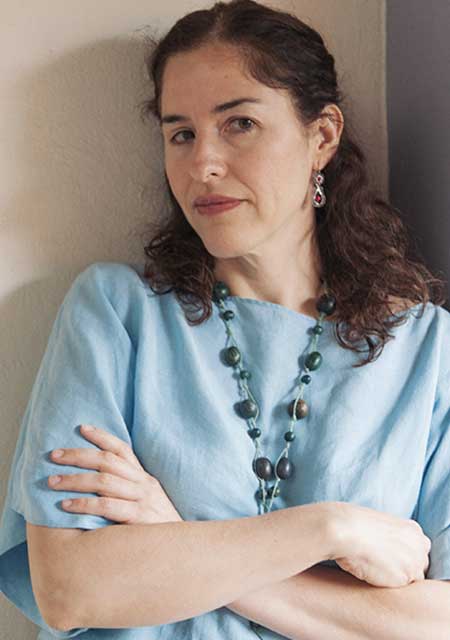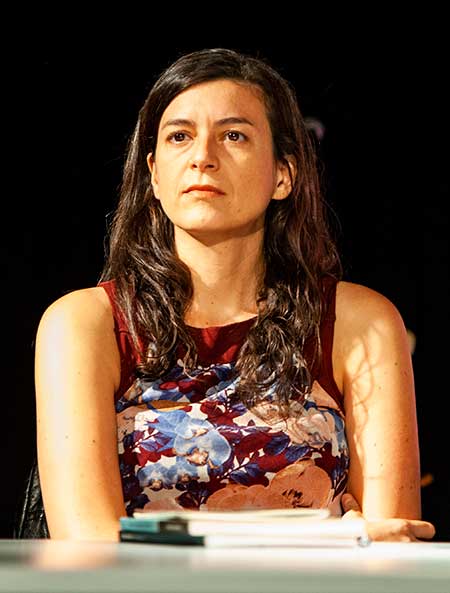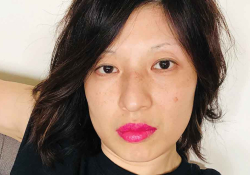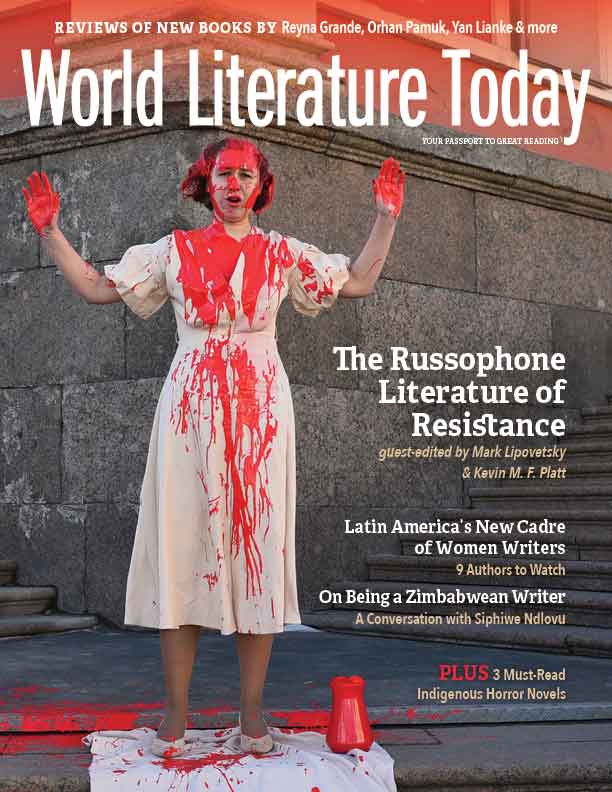Putting a Collective Finger on the Pulse: The New Cadre of Latin American Women Writers
Guadalupe Nettel, Samanta Schweblin, Mónica Ojeda, and other Latin American women writers are responding to themes that particularly speak to a younger, female audience—bodily autonomy, redefinition of gender, the internet’s mediation of identity, and brushes with the existential—in common ways, embracing conventions of the horror and true crime genres and bending them toward literary aims.
Over the past decade or so, a new cadre of female Latin American writers has emerged in English translation. Although each is distinctive in her own right, these writers share enough overlapping themes, approaches, and styles that we might refer to it as a “school,” if not a “movement.” On their common ground are the misogynistic violence that pervades the lives of Latin American women; bodily autonomy, especially around access to abortion; the ongoing definition and redefinition of gender; internet culture and how it mediates identity and personhood; and brushes with the existential. These writers have responded to such themes in common ways; most notably, by embracing conventions of the horror and true crime genres and bending them toward literary aims. Their literature speaks particularly to a younger, female audience, and these authors seem to have a collective finger on the pulse of their readers’ lives.
Although I cannot pretend to have an exhaustive list of the writers in this group, I can name off the ones that currently stand out to me in English translation. In no particular order, they include Guadalupe Nettel, Samanta Schweblin, Mónica Ojeda, Fernanda Melchor, Liliana Colanzi, Cristina Rivera Garza, Valeria Luiselli, Nona Fernández, and Lina Meruane. Certainly there are more currently at work in Spanish as well as others emerging in English translation.
Ojeda speaks in the language of true crime podcasts, streaming serials, creepypastas, and the world of therapy.

A good example of the prototypical novel of this group of writers is Ecuadorian Mónica Ojeda’s 2018 novel Mandíbula, published in 2022 as Jawbone in Sarah Booker’s translation. It tells the story of a schoolteacher for an elite preparatory school for upper-class girls who goes mad, kidnapping one of her students and subjecting her to experiences of body horror. On one level, the book captures many of the central concerns of Latin American writers like Ojeda—body autonomy, the socialization of girls within Latin American society, mental and physical horrors perpetrated against women of the continent—yet it also communicates on levels that are detached from a Latin American context, as it speaks in languages comprehensible to young women throughout the developed world. Specifically, Ojeda speaks in the language of true crime podcasts, streaming serials, creepypastas, and the world of therapy. Regarding some of her literary influences, Ojeda told me: “I have a thing for true crime documentaries. I don’t like to like them because they really hurt me, but I keep going to them. And creepypastas, of course. Not all of them, but some are so very powerful.”
One of the striking things about Jawbone is how it comes across as something along the lines of a true crime podcast or a creepypasta—did you ever hear the one about the teacher who went mad and tortured her own student? It converses with the media resonating with young women across the globe, giving it a currency that transcends its Ecuadoran context. Yet even as Jawbone feels very of the moment, it also connects up with deep-rooted aspects of the Latin American tradition. For instance, the book includes chapters that read as though they are transcripts from one of the main character’s therapy sessions, the speakers only denoted by a Q or an A, and the questions asked by Q not included in the transcript. This tracks back to the powerful psychoanalytical writing that was a core aspect of twentieth-century Latin American literature, reminiscent of Manuel Puig, in particular. In addition, the suggestion that the controversial Catholic organization Opus Dei is involved in the school weaves in a political aspect, staying true to the propensity for Latin American authors to let politics infuse their narratives in subtle and unexpected ways. It also brings to mind canonical Latin American writers like Roberto Bolaño, who referenced the sexual abuse scandals, misogyny, and supposed ties to right-wing dictatorships held by Opus Dei.

The Mexican writer Guadalupe Nettel covers areas overlapping with Ojeda—girlhood, psychoanalysis, the quandary of being embodied—doing it with her own twinge of horror and the gothic. For instance, her 2011 novel El cuerpo en que nací, translated into English in 2015 by J. T. Lichtenstein as The Body Where I Was Born, takes the form of a woman recounting her traumatizing childhood to a therapist (see WLT, Jan. 2016, 65). “We perpetrate unto the newest generation the neuroses of our forebears, wounds we keep inflicting on ourselves like a second layer of genetic inscription.” The narrator recounts a life lived with a scar on her cornea—how this mark of difference has impacted her throughout her lifetime, and how she has come to terms with that congenital wound.
As with Ojeda and other writers of her school, the narrator’s childhood is inflected by the political realities of the period. Nettel’s narrative implicates the political turmoil that gripped Latin America throughout the 1960s and ’70s, including Mexico’s own infamous massacre of students at Tlatelolco in 1968 and the disastrous Pinochet dictatorship in Chile. Nettel also brings in the 1985 earthquake in Mexico City, a watershed moment for the nation and a pivotal turning point on its long, slow journey out of single-party dictatorship and into pluralistic democracy.
Like Ojeda’s book, Nettel’s is about how women are taught to be the subjected gender during childhood and adolescence and the narrator’s own struggle to free herself and to inhabit her body as an autonomous being. The book’s title comes from Allen Ginsberg’s poem “Song,” in which he writes: “I always wanted / to return / to the body / where I was born.” For Nettel’s narrator, claiming ownership over the body she was born in—despite it being disfigured by a debilitating scar over one cornea—is tantamount to learning to live as an independent woman in a world that has taught her at every turn to be dependent and unfree. It is a struggle familiar to the women—whether adults or adolescents—in Ojeda’s Jawbone, and it is a theme running through Nettel’s work. For instance, her short-story collection Natural Histories, translated in 2014 by Lichtenstein, similarly documents women struggling to define freedom on their own terms despite heterosexual relationships that subject them to a variety of misogynistic forces. As in her novel, in these stories Nettel pares back the narrative frame to the basics, letting her focus more closely on the emotions, demoralization, and confusion that her women experience as they seek to gain an understanding of their situation, and ultimately a degree of agency over it.
Nettel pares back the narrative frame to the basics, letting her focus more closely on the emotions, demoralization, and confusion that her women experience.
If Ojeda draws us closely into the existential situation of Latin American women, and Nettel closer still, then perhaps no other female Latin American writer throws a reader as boldly and completely into this state of existential confusion and peril of women as does the Argentine writer Samanta Schweblin. What is most striking about Schweblin’s narratives is that they tend to sit somewhere between realism and allegory, providing enough detail to take them down from the realm of myth or fable but not providing anywhere near enough detail to give a full sense of the reality her characters inhabit, as you would get from typical realist fiction. The result is that when reading Schweblin I always feel very closely—and very intensely—attached to the protagonist’s world of emotions and sensations, as this is usually the bulk of what Schweblin gives a reader to grab onto. Unsurprisingly, it is a world characterized by extremely heightened states, crisis moments, and extremes of mental and physical functioning. I would not be surprised if reading Schweblin significantly raises my cortisol levels.
Schweblin’s world is characterized by extremely heightened states, crisis moments, and extremes of mental and physical functioning.

The results of Schweblin’s particular way of storytelling are narratives that feel like very strange, distinctive, and original takes on concerns familiar to her feminist peers. For instance, her story “Olingiris” is framed around a complaint common to women everywhere: the rituals and practices necessitated by the societal imperative that women have skin free of hair. But Schweblin makes it peculiarly her own: the story’s frame tale is one of women being paid for some never-explained reason to harvest their body hair in excruciating fashion by a team of women wielding tweezers. “Headlights” centers on a woman calming the emotional pain of being scorned by her husband while having a bizarre encounter with an older woman amid a backdrop of the wails of similarly scorned women. Schweblin’s 2014 novel Distancia de rescate, translated by Megan McDowell as Fever Dream (2017), is at heart the tale of two mothers coming to terms with the ever-present potential that their young children might die, but told via the titular fever-dream narration of a woman slowly succumbing to death.
Although the political realities that sit so squarely in the work of Ojeda and Nettel might seem a more difficult fit in the strange worlds of Schweblin, events from the political life of Latin America do make themselves felt in the tales she tells. Schweblin herself has said that Fever Dream was informed by the widespread use of toxic pesticides throughout her native Argentina, which have been linked to disease and death for the townspeople within their range, these pesticides being necessitated by Argentina’s place as a major producer of soybeans in the global economy. Her 2015 collection Siete casas vacías, translated by McDowell as Seven Empty Houses (2022), references the widespread misogyny that has led to epidemics of femicide throughout Latin American nations. One of the book’s epigraphs comes from Juan Luis Martínez’s “The Disappearance of a Family,” widely understood as implicating the politicized violence that Latin American governments visited on ordinary citizens during the twentieth century.
These three writers—and many of their peers, whose work I cannot discuss in detail for reasons of space—are independently arriving at overlapping territory in ways that feel meaningfully similar, despite the originality each brings to her work. They are invoking a universalized idea of womanhood ensconced in the middle and upper classes that is broadly familiar for the way it is reproduced throughout film, TV, music, Instagram, advertising, and so many other forms of media. While they are doing this in a way that is deeply true to their particular cultures and identities as Latin Americans, their stories also feel relevant to any woman who has managed a certain level of stability and material comfort in her life. For instance, the way that Ojeda brings internet horror folklore into her Jawbone, or how Schweblin brings in widespread unease about the ways we connect over social media to her Little Eyes, gives these books a broadness and a relevance as contemporary world literature.
For the mostly female protagonists and antagonists in these narratives, the world is a place not their own— they strive to stay afloat, and they learn the rules to their worlds via trials-by-fire.
For the mostly female protagonists and antagonists in these narratives, the world is a place not their own—they strive to stay afloat, and they learn the rules to their worlds via trials-by-fire. These worlds generally involve a level of danger that the protagonists are continually trying to determine, even as they seek the signifiers of normality that women are pushed to aspire toward, such as beautifying themselves, finding lasting and secure love, raising children, and leading lives full of self-care and stability. If Ojeda, Nettel, and Schweblin find resonance and meaning in the realms of horror, the political, and bodies, and if these realities in turn resonate beyond their Latin American context, it is perhaps because they are in touch with something basic about being a woman in the early twenty-first century.
As Ojeda told me, by writing through the lens of horror she is able to drill down to the basics, which is how writers have always created art that speaks most broadly. “I think we all know fear just as much as we know love. We fear because we love, we fear because we are fragile, we fear because we are all going to die. Love is so beautiful and strong and nevertheless is vulnerable like a flower. What can a flower do against all the dangers in the world? So we tremble, so we try to protect the flower because it is so delicate, so precious. Writing horror makes you think about this kind of stuff and takes you back to myth and symbols, which I love.”
Oakland, California




















